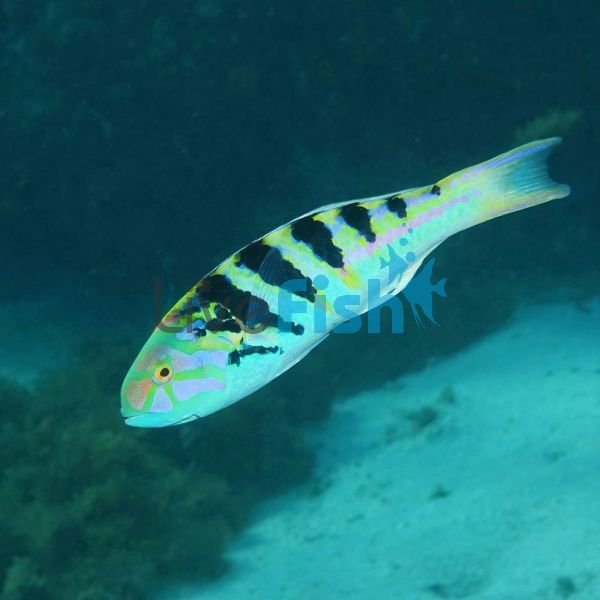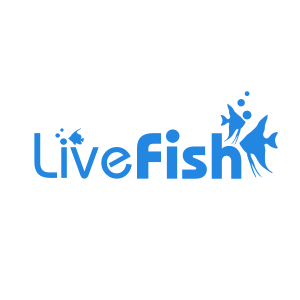Wrasse Hardwick - Medium
The Hardwick Wrasse is a voracious eater that is easy to feed. These fish are always hungry, this isn’t a problem though as they work as cleaner fish picking parasites from other fish. This makes them an excellent fish for assisting with large tank upkeep; after all, happy fish need good maintenance.
As adults the Hardwick Wrasse has a pastel blue body with six vertical dark body stripes and a distinctive "daisy" design around the eyes consisting of several pastel colours.
The male Hardwick Wrasse is more colourful than females. The terminal males (females who turn into males) are, on the other hand, gaudier than the primary males (born males). Until the fish transforms into a male, the colour pattern remains the same. The male and female Hardwick Wrasse are identical in terms of body structure and size.
The Hardwick Wrasse are common and extensively spread throughout the Indian and Pacific Oceans' tropical seas.
Tank Recommendations for Hardwick Wrasse
When it comes to tank setup, wrasse are easy to please. Wrasses may dwell in a variety of habitats, including reef aquariums. However, by consuming small crustaceans and invertebrates that reside on the corals, these fish risk destroying them. Sand should be used as the substrate because they like to dig in it and sleep under rocks and plants. However, a deep sand bed may not be necessary because they can sleep on it without burrowing into the sand. You can keep them in any lighting setup because they are not light sensitive. Because Hardwick Wrasse can live in low-turbid conditions, moderate to high water movement is advised.
Hardwick Wrasses are jumpers, so it's critical to keep your tank lid closed at all times. When it comes to water parameters, the Hardwick Wrasse has no special requirements. However, keeping them in warmer water is recommended because they develop faster and are less shy there. To maintain water quality, the tank requires 10% water changes every two weeks or 20% water changes every month.
Suitable Tank Buddies
The Hardwick Wrasse is a carnivorous species that feeds on other fish and crustaceans. So ensure you keep them well fed to avoid them attacking any less aggressive fish in your tank. They have been know to do this as they always seem to be hungry and on the look out for food. This violent behaviour of Hardwick Wrasse is because they are hunters, and so may feed on smaller, more tranquil fish in your tank. They will not attack if you keep larger, more aggressive fish in your tank with them.
Usually Compatible
Some fish are more tolerant of them, while others are more vulnerable to predation. If you wish to keep your Hardwick Wrasse alongside other fish, make sure they have lots of hiding places and don't keep slow-moving fish in the same tank. Groupers, Angelfish, Triggerfish, and Hawkfish are among the fish that can coexist with the Hardwick Wrasse. Small fish and crustaceans should not be kept with the Hardwick Wrasse since they will eat them. The Hardwick Wrasse as already mentioned should have tankmates that are the same size or greater, as these fish will not bother larger fish.
Sometime Compatible
Small crustaceans and worms that reside on rocks and coral will be eaten by Hardwick Wrasse. They will not eat the corals themselves, but may cause some damage to them whilst feeding. Due to their voracious hunger and aggressive attitude, they are not considered reef-safe. They will eat any fish that is small enough to fit in their mouth. Anglerfish/Frogfish, Anthias, Basslets/Pseudochromis, Blennies, Butterflyfish, Cardinalfish, Clownfish, Dragonettes, Eels, Filefish, Goatfish, Gobies, Grunts, Hogfish, Lionfish, Parrotfish, Puffers Scorpions, Snappers, Squirrelfish and Live Corals should be compatible in a sufficiently sized aquarium.
Rarely Compatible
The Hardwick Wrasse hunts in a similar way to Sharks and Rays looking for invertebrates buried in the sand. Hardwick Wrasse are likely to consume crustaceans, and invertebrates in your tank. They should also not be kept with slow moving fish such as Batfish, Pipefish, and Seahorses, as they will cause them stress and harass them.
Feeding your Hardwick Wrasse
The Hardwick Wrasse is carnivorous fish that eats a variety of meaty foods and so will devour crabs, worms, shrimp, octopus, and small fish. Because these fish are not picky eaters, you can feed them any nutritious food you want. Pellets, flakes, crustaceans, live and frozen brine shrimp, bloodworms, and mysis can all be fed to these wrasses in the aquarium. When small they often work as cleaner fish, picking parasites from other fish.




